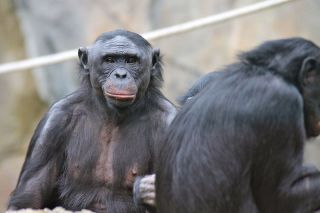Marriage
We Two, We Happy Two...
Monogamy is news again: why do we focus on pairs in social species?
Posted August 31, 2013

Early in August dueling studies came out concluding that monogamy in humans might, or might not, have evolved because of one, or perhaps two, contradictory explanations.
I cannot do better at representing the results than Science News did in its coverage:
One group of researchers says monogamy evolved in primates to counter the threat of males killing babies to boost their siring success. The other team concludes that mammals, including primates, become monogamous when females live far away from one another.
The differences in the studies have raised eyebrows. “They do seem to be saying the opposite thing,” says Anthony Di Fiore, an evolutionary anthropologist at the University of Texas at Austin. “It’s interesting because they use very, very similar methods,” Di Fiore says.
The two groups also disagree on whether the research has implications for why humans evolved fidelity to mates.
I read the research, followed the news coverage, thought about writing about this, but it was, after all, the middle of summer, so in the end I left it go. Then someone dropping by here to comment on an older post of mine got me thinking anew about this whole set of issues.
Monogamy, in the sense used in these studies, is the practice of a male-female pair remaining associated for a long period of time.
One study looked at a sample of mammal species with long term pair bonds. The researchers, Dieter Lukas and Tim Clutton-Brock, checked the correlation of monogamy with factors including "whether that species practices infanticide and whether the females live in discrete territories". When females had territories, they found, mammals were more likely to develop monogamy. This they explained as a result of males adopting a behavior of staying close to one female, to monopolize her reproductively, instead of risking other males moving in while they went off in search of other, more distant females.
The second study, by Christopher Opie and colleagues, looked specifically at primates, not all mammals. They found that in primates, the tendency for males to commit infanticide went along with monogamy:
In nonmonogamous species such as gorillas, males may benefit from killing other males’ babies because losing a baby forces the mother to enter her fertile period sooner. But males that hang around their mate and offspring can defend them from roving killers, so monogamy could have evolved as a counter-strategy, Opie and colleagues suggest. Today, monogamous primates have very low rates of infanticide, and in some cases, such as in titi monkeys native to South America, infanticide has never been observed at all.
Now, here's where I find myself wandering off the script (which calls for me to pit these two studies against each other as if they must be reconciled, even though they are not actually studying the same population...).
While the august New York Times and other news media immediately related these studies to humans, and indeed, Opie and his colleagues included humans as one of the primates under study, I wondered: why are we so riveted by couples in such a very social species?
No one is suggesting that human ancestors behaved like modern gibbons, with their combination of pair bonding and female territories, leading to a kind of nuclear family social world. Human ancestors, like humans throughout their known history, are understood to have lived in social groups. So do our closest living primate relatives.
Carl Zimmer put it this way in covering these studies for the New York Times:
One source of clues to the origin of human mating lies in our closest relatives, chimpanzees and bonobos. They live in large groups where the females mate with lots of males when they’re ovulating. Male chimpanzees will fight with each other for the chance to mate, and they’ve evolved to produce extra sperm to increase their chances that they get to father a female’s young.
Zimmer goes on, as most such coverage does, to pursue the question of just when human ancestors shifted from this more open pattern of mating to monogamy.
He cites the (very complicated; the authors themselves call it "speculative") research of Emma Nelson and colleagues. They look at ratios of the length of different fingers, which derive from differential hormone levels during gestation, which is correlated in primate studies with pair-bonding, concluding that the
ratio of Australopithecus afarensis is consistent with monogamous extant species. The early anatomically modern human Qafzeh 9 and Neanderthals have lower digit ratios than most contemporary human populations, indicating increased androgenization and possibly higher incidence of polygyny.
Got that? By the time of A. afarensis, finger length studies suggest human ancestors were engaging in long term pair bonding. But later, early modern humans and Neanderthals may have gotten back into a more polyamorous pattern; only to have recent modern humans (us) move back towards long term pair bonding again. That should make us pause a bit; perhaps this issue of the origin of monogamy is not a one-time deal, to be explained by a single cause.
I find myself struck by the focus on pairs, abstracted from a social group. Go back and read that description of our bonobo, chimpanzee, and gorilla cousins: these are social animals, like us. And that affects how they (and we) manage mating practices.
Mothers, research tells us, help their bonobo sons do better in the mating game. Adult female gorillas are the ones that normally initiate sex, and it seems they are picking the biggest males around. And of course, most famously, Sarah Blaffer Hrdy widens the lens of human evolution to suggest that for our ancestors,
if the young were to survive in a world of scarce food, they needed to be cared for, not only by their mothers but also by siblings, aunts, fathers, friends—and, with any luck, grandmothers.
Where are all these other social actors?
I can't help wondering if the emphasis on just the physical reproductive pair is as much a reflection of very modern ways of thinking about reproduction. Despite their differences, male ancestral primates imagined as policing the sexual liaisons of a female, to the point of killing offspring of uncertain origin, could belong in an anonymous suburb today, as an unpalatable essence of the atomized nuclear family: mom and dad and their own children, without others to influence their behavior.
The actual evidence of our closest primate relatives is something else entirely: there are always others in the scene. Why male-female bonds endured longer or dissolved at various points in the history of our species cannot be explained without taking these others and the social setting they create into account.




